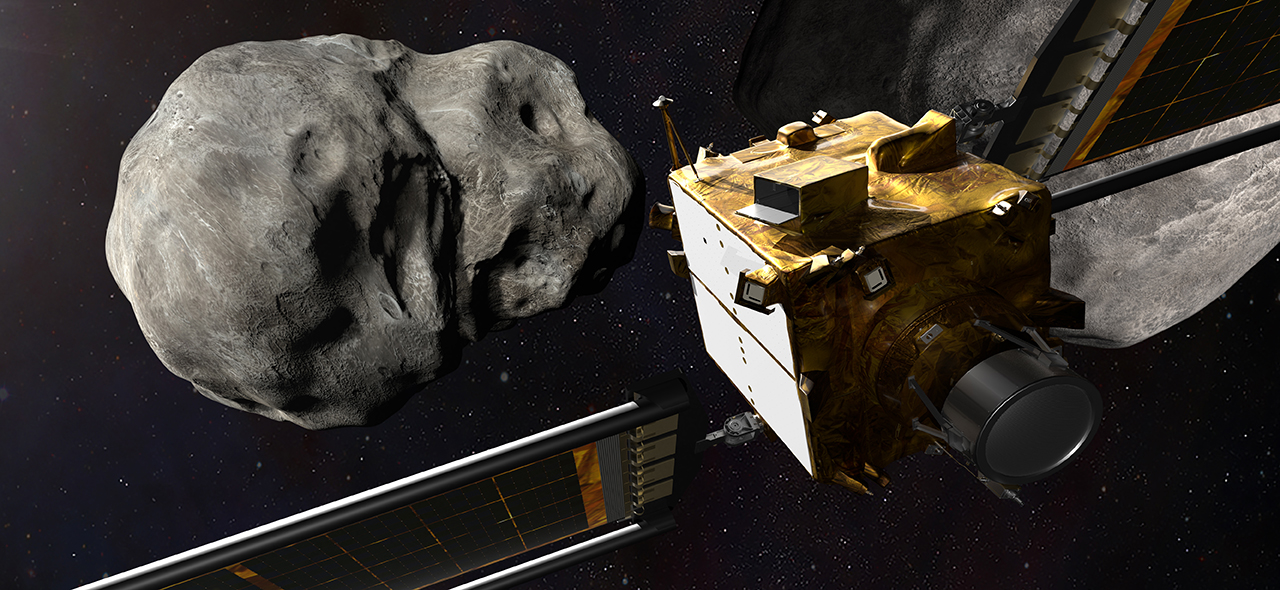National Aeronautics and Space Administration, Public domain, via Wikimedia Commons
Last Monday, NASA released a statement announcing the successful completion of its ten-month long Double Asteroid Redirection Test (DART), the first ever mission to address the issue of planetary defence against objects from space that could cause severe harm to our planet.
The core aim of the project revolved around investigating kinetic impaction as a viable mitigation strategy to defend against potential interplanetary threats, like those of asteroids and meteorites. It is also one of the many solutions that have been proposed by scientists over the ages to protect our planet, and involves ejecting an impactor (the spacecraft) at extremely high speeds towards an approaching object with the intention to deflect its trajectory and avoid a potentially catastrophic collision with Earth.
The target of the DART mission was a small moonlet of the name Dimophos lying just 11 million kilometres away, and orbiting around its much larger parent asteroid, Didymos.
These two asteroids form part of what is called a “binary asteroid system”, a pair of asteroids orbiting around a common centre of gravity. Researchers chose this moonlet to study the effects of kinetic impact because binary systems permit the use of only a single spacecraft when studying the effects of kinetic impaction, therefore saving time and resources.
It is also much easier to measure changes in the orbit of a binary asteroid than that of a single asteroid around the Sun. This is because the moonlet’s orbital speed around its parent asteroid is relatively slower, allowing for more accurate and practical measurements to be taken regarding changes in orbital direction and speed that can provide insight into how kinetic impact affects its targets.
The DART spacecraft successfully collided with its target Dimorphos last Monday at 7:14 p.m. EDT, at a speed of 22 530 km/hr. Researchers predict the effects of this to be a reduction in the moonlet’s orbital speed around its asteroid by approximately 10 minutes, or 1%.
Although neither asteroid poses a current threat to Earth, the duo were still chosen owing to their high visibility in deep space, providing researchers with a better vantage point to observe the position of the asteroids in the moments leading up to, and following, the crash.
Before the mission could take place, the team at NASA first had to address a few issues regarding the logistics of targeting their chosen moonlet, Dimorphos. The small size of the asteroid (~160 metre diameter), coupled with its distance from us here on Earth, meant that it was difficult to separate its position from those of other asteroids in the Solar System, including its own parent asteroid with which it lies in close orbit with.
15 days before the collision was scheduled to happen, the team also deployed a Light Italian CubeSat for Imaging of Asteroids (LICIACube) to follow after the spacecraft. Its purpose was to capture additional images of the asteroid’s surface, and of the resulting cloud of ejecta after impact. These could then be relayed back to mission control to help assess its effectiveness as a strategy for asteroid deflection, should the need arise in the future. Beyond this, the LICIACube aims to measure and characterise the composition and surface structure of the asteroid based on ejecta analyses and to measure crater size and morphology of Dimorphos’s non-impacted hemi-sphere.
The overall success of this mission will be confirmed once changes in the asteroid’s orbit as a result of the collision have been observed.
AI and computer models will then measure and assess these changes to determine both the effectiveness of the DART mission and use of kinetic impaction as a viable strategy that can be used in the future.
The information obtained from this mission will provide invaluable insight that can help improve our understanding of how defence strategies such as kinetic impaction can be implemented when faced with immediate interplanetary threat. Not only that, it can also incentivise research looking into the production of novel planetary defence tools, allowing us to better defend our planet.
Despite this, there are still some problems future missions will need to address if we are to improve our anti-asteroid defence system, namely, the fact that the size of the asteroid determines the length of time taken to build a suitable impactor for contact. Many researchers still believe this form of defence might not be as effective with larger asteroids because the greater diameter and mass may be difficult to overcome with a spacecraft.
In the meantime, scientists will continue observing the orbital changes in the binary asteroid system and take measurements over the course of the next few months to better understand the long term effects of the kinetic impaction strategy. The European Space Agency (ESA) has already announced a follow-up mission in 2024 that involves sending another spacecraft up to Dimorphos to investigate the after-effects of the DART mission.
The DART mission poses a new frontier into the world of planetary defence. The success of this mission will likely inspire multiple future projects looking to protect our planet.
These depend not only upon our current understanding of asteroid behaviour and defence, but also on more advanced technologies and defence strategies yet to be developed. Such innovations in space exploration may also have repercussions outside planetary defence. By providing a deeper insight into our Solar System, the DART mission may aid a deeper exploration of our Solar System and even change the way we understand our Universe. Indeed, we are yet to see the full range of potential unlocked by DART.





